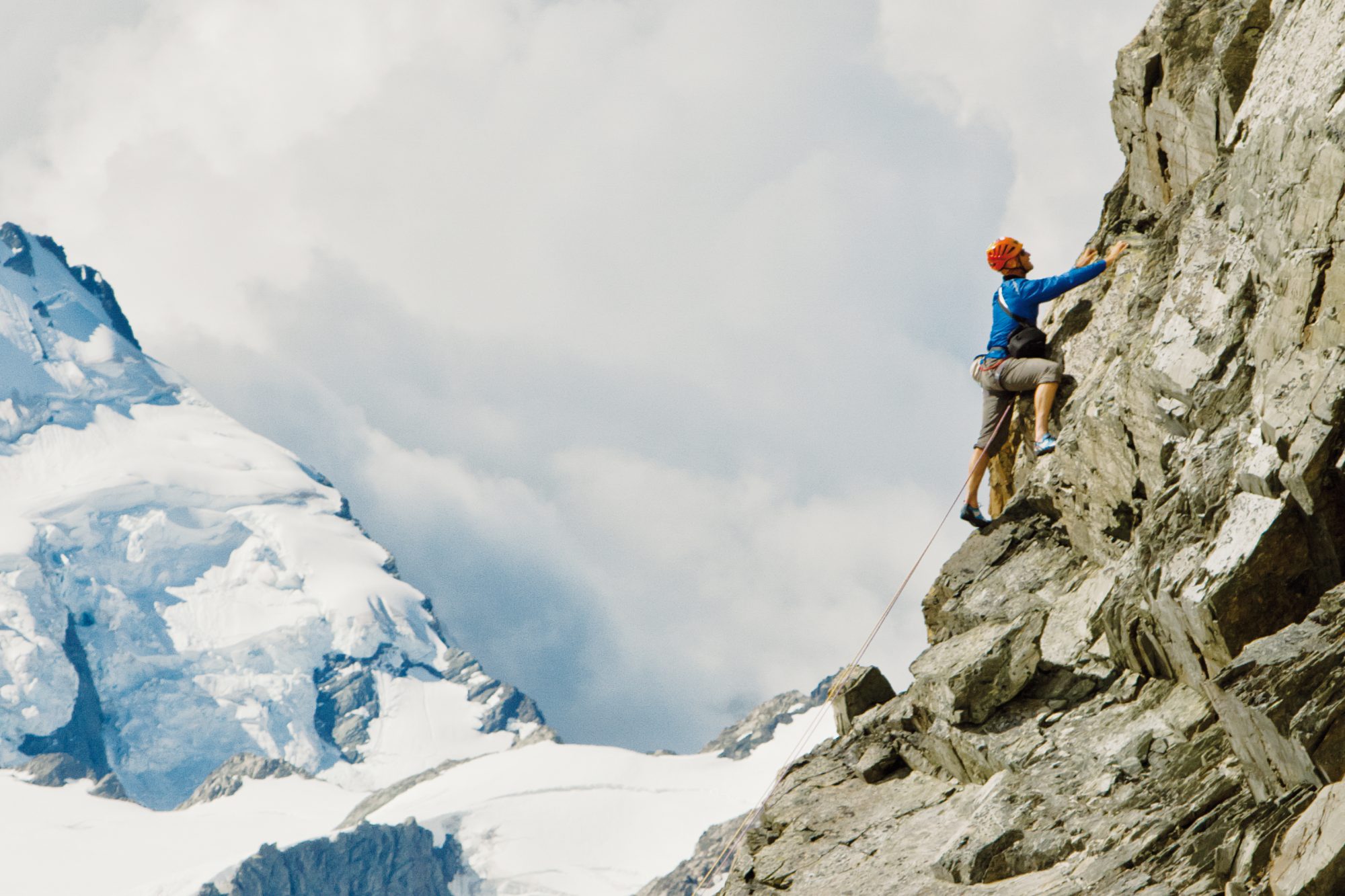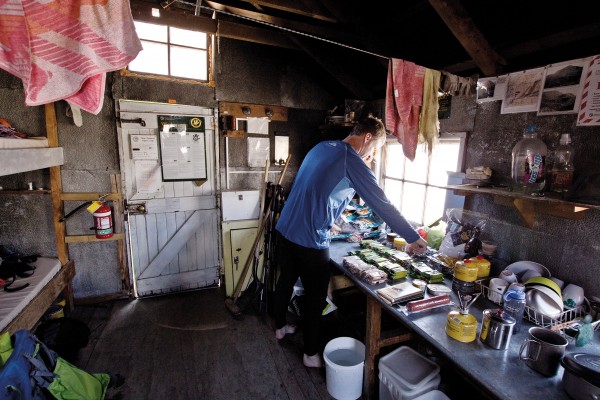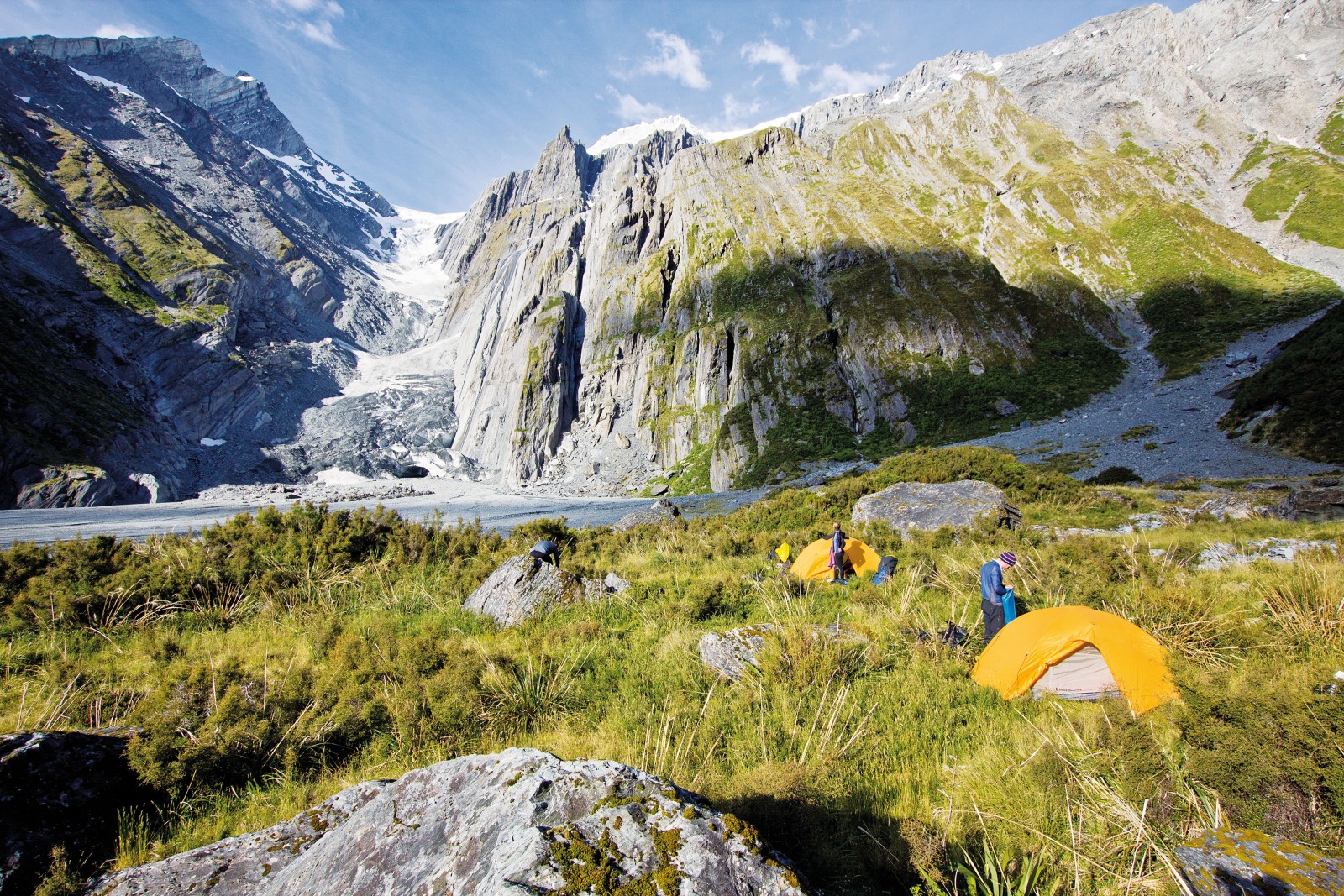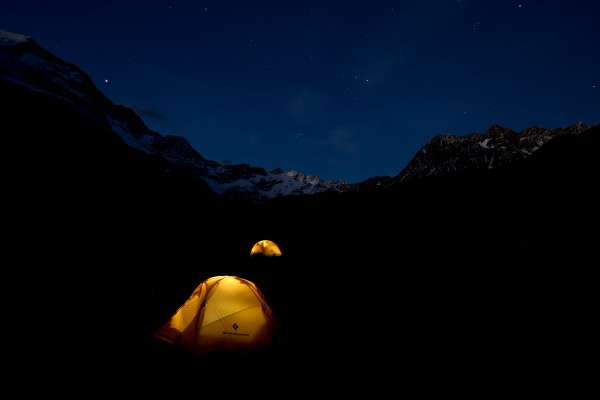
To Haast, the Hard Way
In summer, a team of climbers embarked on what would be an ambitious and gruelling attempt to traverse the Southern Alps. They began on bicycles in Christchurch and, more than a month later, finished in Haast, having walked 200 km—some on trails pioneered by Charlie Douglas more than a century ago, other times
taking routes no one had attempted before.

Step after step, I plugged up the steep snow slope. Ice axe shoved into the soft snow to stabilise, then a staccato kick-kick of each crampon for purchase against the slippery surface. The steady rhythm of the climbing gradually ate away at altitude.
In the hundreds of metres of space beneath my boots, thick cloud swirled, cloaking my companions in a blanket of haze the colour of dirty dishwater. Visibility was a paltry few metres. On either side of the narrowing gut, dark walls of impassable rock angled in, like closing curtains. The only sound was our heavy breathing, the occasional clatter of falling stones and the hissing of snow as it sloughed from our steps.
I began to wonder if the route we’d committed to would work out at all. This was a tramping pass, I told myself. This was supposed to be easy.
A voice fell through the gloom and echoed off the walls until the location it came from was lost in the mist. A few minutes earlier, the strongest climber in our group, Jamie Vinton-Boot, had clambered up the snow chute, searching for a way over into Separation Stream. Now he was calling directions somewhere above us, ingested in the mass of cloud.

The four of us were scratching around high above Forbes Stream, trying to traverse from the Havelock River catchment into the Godley. Initially, we had hoped to climb over Separation Col, across the glaciated eastern flank of Mt D’Archiac. But the thought of weaving through cavernous crevasses in a whiteout had us searching for an alternative route over Twilight Col instead.
This climb was one of many on our 200-km transalpine journey from Erewhon Station, inland of the Canterbury Plains, to the Otoko Valley just north of Haast on the West Coast. The arduous route involved traversing the length of the Southern Alps and attempting a number of unclimbed mountain faces along the way. In all, it would take our small team 32 days.
We had already cycled 180 km from Christchurch to Erewhon, and picked our way up the braided valleys against a gusty north-westerly, before staring into blank infinity on Twilight Col. This was our first lesson of the trip: backcountry travel would be dictated more by the weather than our aspirations or endurance.
[Chapter Break]
“Nature’s true wonder don’t disclose themselves to day-trippers,” wrote the explorer Charlie Douglas. Considered by many to be the grandfather of transalpine travel in this country, ‘Mr Explorer Douglas’ was renowned for difficult trips through our remotest valleys and passes during the 1800s. Over 40 years, he explored and mapped hundreds of kilometres of West Coast backcountry, and while he didn’t consider himself a climber, some of the mountainous terrain he covered was certainly more challenging than bush-whacking—sometimes for no better reason, noted John Pascoe in his biography Mr Explorer Douglas, than “to get a view”.
Douglas learned to travel and survive with meagre provisions. A bearded, compact and shy man, he showed tenacity in atrocious weather and patience in trackless, fractured landscape, often travelling with only his dog—first Topsy and then Betsy-Jane—for company.
He was a keen observer of the environment and, in the days before freeze-dried food, supplemented his basic rations by hunting native birds and other wildlife. (His tongue-in-cheek recipe for weka has become famous: Place one plucked and gutted weka into a pot of water. Add rocks and boil. After an hour, discard the weka and eat the rocks.)

Hundreds were inspired to follow in the muddy footsteps of Douglas, including me. But transalpine trips involve negotiating some of the most exposed topography in our mountains. Taking the least pleasant aspects of climbing and tramping and blending them into something else entirely, they are the closest we get to backcountry expeditions in this country. Modern-day alpinists have benefited from more palatable food and better and lighter equipment, which have eased the burden a little. (For our team, technical equipment for attempting the unclimbed mountain routes added significantly to the weight of our packs.)
A life of ease was never on the agenda for Douglas. “The impulse drove me out into the world, but the desire to then settle must have been omitted in my moral character, as here I am after thirty years wandering, crouched under a few yards of Calico, with the rain pouring & the Wind & Thunder roaring among the mountains; a homeless, friendless Vagabond, with a past that looks dreary & a future still more so,” he wrote on one wet exploration of the Waiatoto Valley.
“Still, I can’t regret having followed such a life & I know that even if I & thousands besides me perish miserably, the impulse which impels them to search the Wild places of the Earth is good.”
[Chapter Break]
Trident Tarns Clung to the boulder-strewn north-western slopes of Mt D’Archiac. Huge cracks in the earth illustrated how these mountains were being torn apart by rainfall, erosion and tectonic activity—like our lawn back in Christchurch, but on a much larger scale. Nearby, deep canyons plunged hundreds of metres to the remnants of the Godley Glacier. It was an unnerving place to pitch our tents.
After crossing Twilight Col in the cloud and reaching our first food drop at Godley Hut, we ascended again. None of us had climbed in this remote pocket of the Southern Alps before, and we took turns orienting ourselves to the map.
But the landscape felt alive. Fat green grasshoppers threw themselves haphazardly from alpine grasses, and a disturbingly large black spider terrified me for a moment while drinking from a stream—to the profound amusement of my wife.
Swathes of dark cloud started boiling over the Main Divide at first light. Hoping to attempt D’Archiac’s unclimbed northwest face, we scrambled across rocky outcrops, skirted more large cracks in the earth and avoided the sprawling faces of rotting black argillite that looked as though they were about to disintegrate. The cloud kept coming. By the time we traversed a hanging glacier to the base of the north-west face, it was threatening to rain. On day eight of the trip, our first climbing attempt was over before it started.
The weather didn’t let up. Gale-force north-westerly winds, then low cloud and constant drizzle, accompanied us from the Godley across Armadillo Saddle into the Murchison Valley. Around lunchtime on day 12, the sun finally broke free of its veil, hinting at an opportunity to climb.


From our campsite on the edge of the moraine wall above Murchison Glacier, we clambered upwards towards the unclimbed west face of Mt Conrad.
It was mid-afternoon by the time we had roped up to ascend Conrad’s rock slabs. Sharing leads, we inched up the face, hoisting our frames hand over hand up steep corners and across broken ledges, searching for a route towards the summit ridge where no one had succeeded in the past. It was gruelling.
Just after 7pm, we hoisted ourselves onto the summit ridge, tired but jubilant. We hugged one another, then looked out over yet another dense system of cloud billowing to the west. All thought of success was quickly forgotten in the face of another approaching front. By the time we returned to our tents two hours later, the rain had started again.
The patchy weather continued the next day. We packed up our tents and climbed down a crumbly moraine wall onto the broken Murchison Glacier. We followed the melting ice of the Murchison, reaching its bulging terminal lake, before crossing the wide belly of the lower Tasman Glacier, and finally reaching Aoraki Mount Cook Village.
It was time to regroup and replan the route for the weeks ahead. The worst storm of summer dumped half a metre of snow on the Mount Scissor slabs, our proposed pass from Mount Cook into the head of the Landsborough Valley, where our second supply drop lay waiting. A detour over Jamieson Saddle into the head of Dobson Valley was inevitable, but the fresh snow would vex even that route, adding two days to a crossing that would ordinarily take a few hours.
Concerned about running out of food, we scavenged what we could from hut shelves in the Dobson and Hopkins valleys. Self-doubt crept in. We began to argue over the competing strategies of caution in the continuing bad weather, versus the desire we all shared to press on despite it. Our small group splintered into personal worlds of exhaustion. For the first time, I wondered if the four of us had the fortitude to complete the trip. The weather just wouldn’t let up. Where had summer disappeared to?
We struggled to Brodrick Hut, near the head of the North Huxley Valley, as another storm hit the mountains. Cold and soaking wet, we lit the fire and climbed into our sleeping bags. Outside, heavy rain and strong wind lashed the hut. The beech forest around our shelter creaked and groaned.
On day 25, we finally crossed the Brodrick Pass and descended into the Landsborough Valley. We had something to smile about again. Our food drop was on the other side of the river, and the weather looked as though it might be settling.
The Landsborough was deep in Douglas’ territory. He had spent many months exploring its reaches, and wrote often of the bird life he encountered there. While not beyond eating them, he enjoyed their company and had a particular soft spot for weka.
“Here is a bird full of good qualities and whose vices lean to virtue’s side,” he wrote. “Personal valour of a high order. An undying thirst for knowledge—unthinking people give it another name—which causes it to annex everything portable about a hut and carry it into the bush to study at leisure.”
It was not the weka but the inquisitive kea that kept us checking our gear. Though, like Douglas, we were treated to boisterous birdlife, with sightings of long-tailed cuckoos, rock wrens, riflemen, bellbirds and feisty tui.
Our final alpine pass—the Upper Otoko—was also our most challenging. On day 28, we found ourselves contemplating a 70º rocky gut the stability of kitty litter. There were no decent abseil anchors, which meant we couldn’t use a rope, and back-tracking would have taken hours. I stared blankly at the others, took a deep breath, and slid into the gut after Jamie. We all managed to climb down the fractured rock, but it remains an experience firmly inscribed upon the list of ‘Things I Never Want To Repeat’.

Two days later, Jamie and Shelley started up a new route on the north face of Mt Hooker. (The length of the face and the amount of time it would take meant only two of us could climb.) Troy and I followed the others up to the foot of the face, and watched as they climbed into the distance, becoming mere specks against its broad, rocky mass. We followed their progress through binoculars, finally losing sight of them in a gully system. Even from our distant vantage point, the climb looked difficult.
Troy and I took turns scrambling up various boulders scattered around our camp to pass the time. Across the valley, a family of thar chased one another across scree and snow with reckless abandon.
On dusk, Jamie and Shelley returned, looking exhausted.
“That was the hardest and worst climbing I’ve ever done in the mountains,” said Jamie. “No wonder no one has been able to get up the face before.” Shelley dumped her pack by our tent and slumped onto the soft grass. “I won’t be recommending the route to anyone in a hurry,” she said.
They described long stretches of simul-climbing with only a rope between them as there were no anchor points to belay from—one’s life quite literally in the hands of the other.
The following day, the second to last, we received the sort of welcome the West Coast was famous for. Rain fell in torrents, rock faces crashed with waterfalls, and the bush became heavy, humid and slippery. We followed deer trails through thick forest down the Otoko, camping at Stag Flat as the river flooded beside us. I was too wet and tired to worry about the weather. Even the sand flies gave up, hunkering down until the rain eased.
Our last day dawned fine and clear, though it couldn’t displace an odd sense of melancholy. My desire for pizza and a shower was offset by a realisation that the simplicity of our existence over recent weeks was about to be shattered by our imminent return to the modern world. As we walked the final few kilometres to Paringa and the Haast Highway, I thought of Douglas and his distaste of most things urban. In his final years, he became increasingly embittered towards ‘easy living’. He preferred the simple life in the wild, basic food, tobacco for his beloved pipe and, sometimes, good company.
“Fools think that knowledge can only be got from books and call me a fool for wasting my life in mountain solitudes,” wrote Douglas in late December 1902, deep in the Westland rainforest. “But if in so doing I have found nothing new in thought or worth giving to the world, I have at least gathered glimmerings of truth as to how nature works, glimmerings which if they bear no fruit in this life, may in the next where darkness will be light.”
















